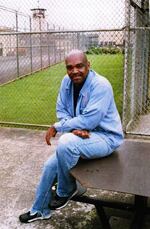The Oregon Court of Appeals has ordered a new trial for a Black man who has been on death row for 17 years.
The court said in Wednesday’s ruling that evidence that never made it into Jesse Lee Johnson’s 2004 trial was the fault of poor defense counsel at the time. That evidence consisted of a witness to the decades old Salem homicide. The Court of Appeals also ruled that the judge who oversaw Johnson’s post-conviction case wrongly found the evidence would not have changed the conviction at trial.
“This was a case where there were a series of mistakes that led to this injustice,” said Ryan O’Connor, Johnson’s attorney. “Systemically, it’s a recognition of the way police misconduct and racism cause wrongful convictions and injustice.”

Oregon Supreme Court in Salem, Ore., May 19, 2021.
Kristyna Wentz-Graff / OPB
The Oregon Department of Justice has 35 days to decide whether to appeal to the state Supreme Court. Otherwise, the case will head back to Marion County where the district attorney’s office will complete a review before deciding whether to retry the case.
“Until a full review is complete, we are not in a position to discuss any details about the case, the appellate decision, or next steps,” Deputy District Attorney Amy Queen said in a statement.
During the early morning hours of March 20, 1998, Harriet Thompson was stabbed in her Salem home. Police arrested Johnson one week later on a probation violation. Johnson told police he knew Thompson. Police had recovered fingerprints and a cigarette butt with his DNA inside Thompson’s apartment. According to a police informant, Johnson said he “offed the bitch to rob her.” That informant gave conflicting statements to Johnson’s defense team, but ultimately stuck by the accusation at trial. A witness also said jewelry that was in Johnson’s possession matched jewelry that belonged to Thompson.
In 2004, a jury found Johnson guilty and sentenced him to death. Since 2011, Oregon’s governors have maintained a moratorium on the death penalty that has stopped executions, including Johnson’s.
During Johnson’s post-conviction case that ended in 2015, investigators discovered a witness who was never contacted by police or the defense team.
During a 2013 deposition, Patricia Hubbard, one of Thompson’s neighbors, said she was sitting on her porch at 3:45 on the morning of the murder. Hubbard said she saw a white man drive up in a van, park in Thompson’s driveway, and go inside. She recognized the man as someone who had been to Thompson’s home many times before.
Hubbard heard screaming and a fight from inside the house. She said she recognized the man’s voice as the same white man who she had seen at Thompson’s several times before. As the shouting became louder, Hubbard said she heard “sounds like pots and pans crashing” and screaming that “got higher pitched and louder and more intense in volume the longer it went on,” the appeals court stated in its ruling. “She heard screaming, then a thud, and then total silence.”
After about 30 minutes, Hubbard saw the man exit out of the back door, his feet “’didn’t even hit the steps,’” the ruling notes.
“’Just flew off the steps and took off running ... flying,’” Hubbard stated.
After she saw the man, Hubbard got a call and had to return to work, according to her deposition. When she returned home later that morning, police were on her block. Hubbard testified that she told an officer outside the crime scene that she had information that might help in the case. The officer told her to go home, she said.
Later, a neighbor brought a Salem police detective to Hubbard’s home
According to Hubbard, the detective stopped her from recounting what happened, and said the case was moving ahead. In this exchange, Hubbard said the detective used a racial slur to refer to both Thompson, who was Black, and Johnson. The court noted in it’s ruling this was evidence of racial bias in the police investigation and a failure to properly investigate.
Separately, Johnson’s original defense team spent just six hours canvassing the neighborhood. They never talked to Hubbard.
The appeals court agreed that Hubbard’s testimony at trial could’ve been significant and affected the outcome.
“Adequate trial counsel would have recognized the importance in a capital murder case of contacting the people nearby who were likely to have information about the victim, people associated with the residence, and the events of the night in question, when a violent murder occurred in a nearby home in the early morning hours when many residents would likely have been at home,” the court found.

Jesse Lee Johnson was convicted of aggravated murder in 2004 and sentenced to death. On Oct. 6, 2021, the Oregon Court of Appeals ordered a new trial after it agreed Johnson's defense attorneys at the time didn't do enough to find a key witness who could have changed the outcome.
Ryan O'Connor
The Court of Appeals also ruled the post-conviction judge erred in determining Hubbard’s omission from the original trial didn’t prejudice Johnson’s case.
“A reasonable investigation would likely have led to finding and interviewing Hubbard, which in turn would have led to evidence and testimony that could have tended to affect the outcome of the trial,” the court stated.
Attorneys working with Johnson have also raised questions about other evidence at the scene of the crime. While Johnson’s DNA was found on a cigarette in Thompson’s apartment, it wasn’t found in anything closely associated with the murder.
“Of the evidence that was DNA tested, none was matched to [Johnson],” the court stated. “[He] had boots that had similar soles to ones that had left prints in blood at the murder scene, but petitioner’s boots did not test positive for blood.”
O’Connor said there is an unknown person’s DNA in the apartment. Blood at the scene of the crime was recovered from Thompson’s bathroom, but forensic tests showed it did not belong to Thompson or Johnson.
“The DNA where you’d expect the killer’s to be is not Johnson’s,” O’Connor said.
The Oregon Innocence Project is representing Johnson in an ongoing appeal around DNA evidence testing in Johnson’s case.
